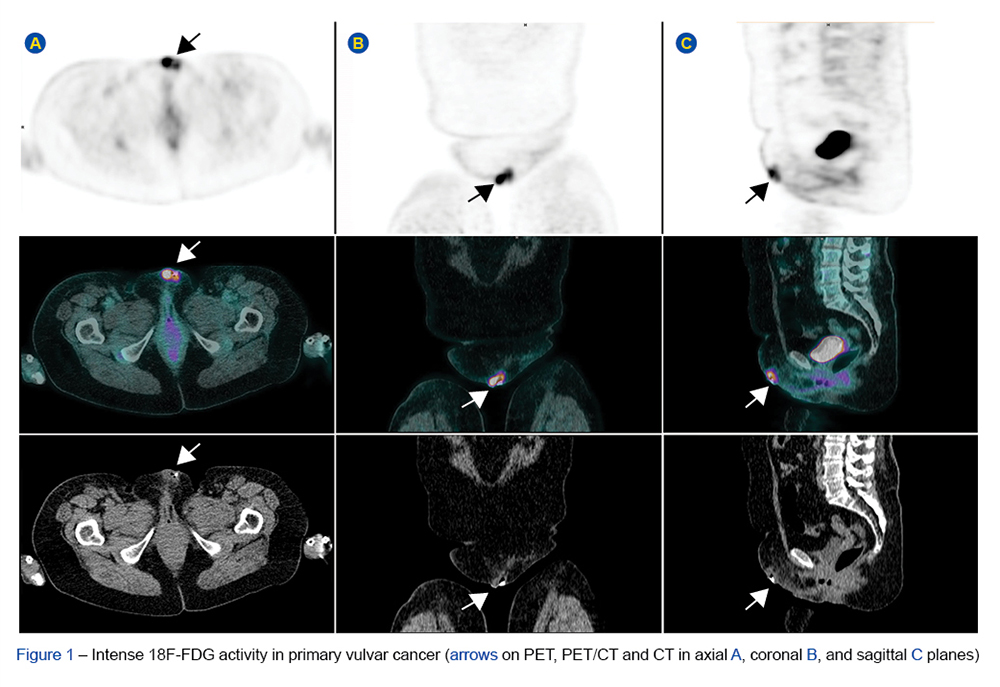SOCIAL MEDIA
Portuguese Medical Association's Scientific Journal

Introduction: Despite the growing evidence supporting the use of 2-[F-18]-fluor-2-desoxi-D-glucose positron emission tomography/computed tomography in cervical and ovarian malignant tumours, data on vulvar and vaginal cancer is sparse. Our aim was to assess the role of 2-[F-18]-fluor-2-desoxi-D-glucose positron emission tomography/computed tomography in patients with vulvar and vaginal cancer.
Material and Methods: A retrospective study was conducted on a cohort of 20 patients with biopsy-proven vulvar (n = 17) and vaginal (n = 3) cancer who performed 2-[F-18]-fluor-2-desoxi-D-glucose positron emission tomography/computed tomography, between January 2013 and April 2018. We collected the clinical data of all patients, as well as the indication for 2-[F-18]-fluor-2-desoxi-D-glucose positron emission tomography/computed tomography, its results, and the main lesion maximum standard uptake value (SUVmax). In addition, we correlated the results of 2-[F-18]-fluor-2-desoxi-D-glucose positron emission tomography/computed tomography with other diagnostic modalities, namely histological findings, computed tomography and magnetic resonance imaging. Patients were divided into two groups, one with newly diagnosed disease and another with recurrent disease.
Results: Six patients had newly diagnosed disease and 14 had recurrent disease. The main lesion was detected by 2-[F-18]-fluor-2-desoxi-D-glucose positron emission tomography/computed tomography in five out of six patients with newly diagnosed disease and in all 14 patients with recurrent disease. Additional sites of 2-[F-18]-fluor-2-desoxi-D-glucose uptake were identified in inguinal and iliac lymph nodes and in distant lesions. Magnetic resonance imaging and computed tomography were performed in 12 cases. In four patients with recurrent disease, abnormalities (main lesion/ metastatic lymph nodes) identified by 2-[F-18]-fluor-2-desoxi-D-glucose positron emission tomography/computed tomography were not detected as suspicious by computed tomography.
Discussion: In our study, 2-[F-18]-fluor-2-desoxi-D-glucose positron emission tomography/computed tomography identified abnormalities more often than conventional computed tomography scans in recurrent disease. In comparison with histology, 2-[F-18]-fluor-2-desoxi-D-glucose positron emission tomography/computed tomography had a sensitivity of 95% and a positive predictive value of 100% in identifying the primary tumour and the recurrent main lesion. Little data is available regarding the usefulness of 2-[F-18]-fluor-2-desoxi-D-glucose positron emission tomography/computed tomography in the management of vulvar and vaginal cancers. The existing evidence supports a high accuracy in detecting lymph node metastases and a change of 36.0% - 61.5% in patient management. Our findings reinforce the usefulness of this technique in vulvar and vaginal cancer. Limitations of our study include its retrospective nature and the rareness of both vulvar and vaginal cancer, which leads to a small sample size and few comparative imaging tests.
Conclusion: In this preliminary study, 2-[F-18]-fluor-2-desoxi-D-glucose positron emission tomography/computed tomography demonstrated it can be a useful method in patients with vulvar and vaginal cancers, namely in defining the extent of disease and contributing to accurate staging and restaging.